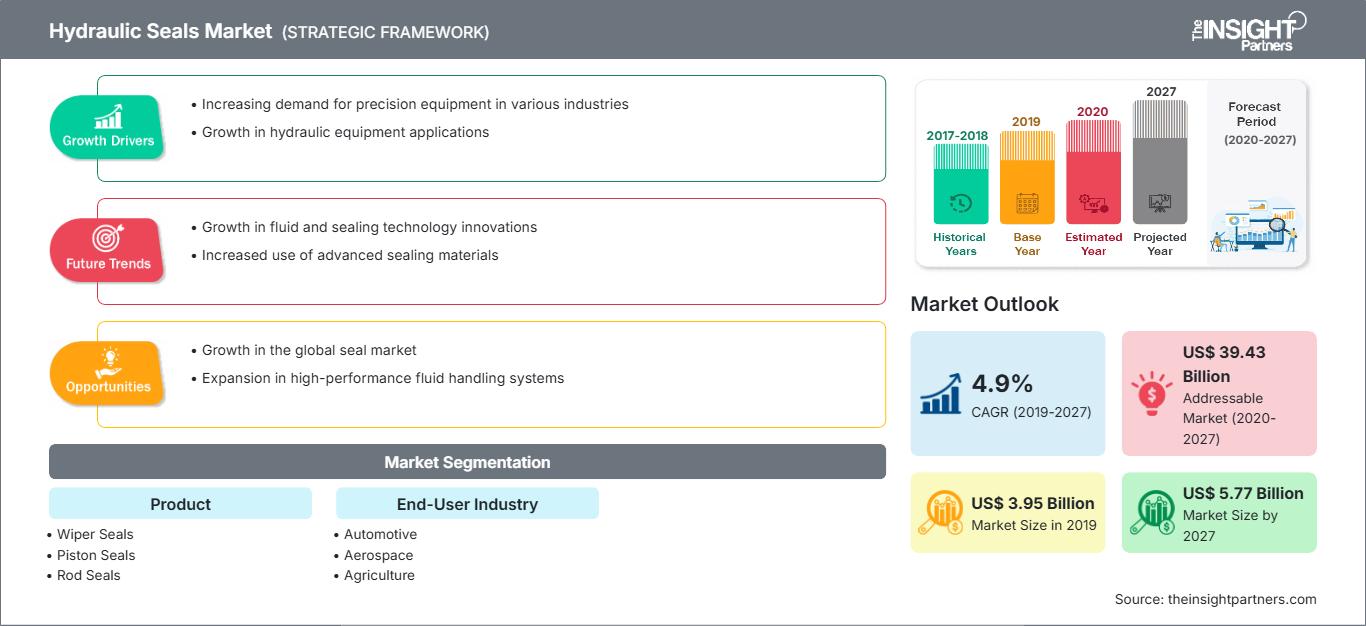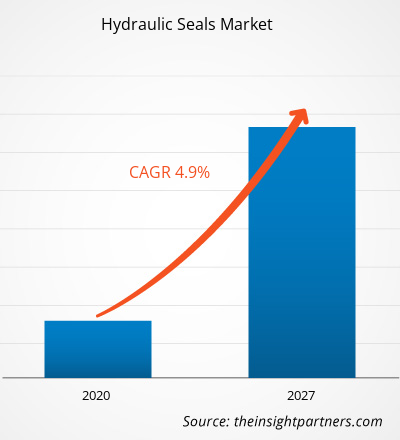The hydraulic seals market was valued at US$ 3,950.09 million in 2019 and is projected to reach US$ 5,770.71 million by 2027; it is expected to grow at a CAGR of 4.9% from 2020 to 2027.
Hydraulic seals are highly preferred by various end-user industries and are broadly used in hydraulic transmission systems. This is due to the numerous advantages offered by hydraulic sealing systems in providing efficient leakage protection control. Hydraulic seals are critical in machinery equipment. Process industries have unfavorable conditions that generally deteriorate the material of the equipment. These conditions have forced the vendors to manufacture hydraulic seals with high-quality materials that can withstand heavy-duty operations. Hydraulic seals are highly recognized for their excellent sealing ability in oil and pressure systems. Hydraulic seal prohibits dirt from entering any part of the internal mechanical system and thereby prevents contamination.
North America is estimated to register the fastest CAGR in the Hydraulic Seals market over the forecast period. Several domestic and multinational companies in the hydraulic seals market already have a strong foothold in North American countries like the U.S. and Canada. Hydraulic seals are employed throughout aircraft hydraulic systems to reduce the internal and external leakage of hydraulic fluid. They prevent the loss of system pressure. The increased utilization of hydraulics and pneumatics in aircraft systems has stimulated the aerospace industry's adoption of hydraulic seals. Manufacturers in the region are striving to provide innovative products to their customers and thereby to gain a huge share in the market. For instance, in 2020, Greene Tweed, a global manufacturer of high-performance seals located in the U.S, introduced its new L-Cap seal for hydraulic systems in aerospace applications. Made with proprietary Avalon PTFE, Arlon PEEK, and elastomer materials, the new L-Cap seal is anticipated to exceed industry standards for performance and durability, minimal fluid leakage, ensuring long service life, and excellent performance across a wide temperature range.
The ongoing COVID-19 pandemic has altered the status of the hydraulic seals industry. The chemical & materials is one of the major industries suffering serious disruptions such as supply chain breaks, technology events cancellations, and office shutdowns. As much as the outbreak has distorted operational efficiency and disrupted the value chains due to the sudden shutdown of national and international boundaries, it has also positively impacted the demand for hydraulic seals. However, as the economies are planning to revive their operations, the demand for hydraulic seals is expected to rise globally in the coming months. Although, the focus over just-in-time production is another factor hindering the hydraulic seals market growth. Also, the increasing prevalence of COVID-19 cases is likely to grow the demand for hydraulic seals during the forecast period. Further, significant investments by prominent companies in the development of advanced products is, yet, another factor supporting the market growth
Customize This Report To Suit Your Requirement
You will get customization on any report - free of charge - including parts of this report, or country-level analysis, Excel Data pack, as well as avail great offers and discounts for start-ups & universities
Hydraulic Seals Market: Strategic Insights

-
Get Top Key Market Trends of this report.This FREE sample will include data analysis, ranging from market trends to estimates and forecasts.
Market Insights
Innovations in Hydraulic Seals Industry
Key players in hydraulic seals market are designing innovative seals with high-quality materials and also to capture a fair amount of market share. The hydraulic seals market consists of several well-established players. Moreover, these companies are also offering innovative hydraulic seals to their customers. For instance, In February 2019, Parker Hannifin Corp launched a new taiyo compact hydraulic seal, which protects the primary hydraulic cylinder by decreasing the chance of the piston contacting the body. In September 2018, Trelleborg Group developed innovative materials for hydraulic seals, and these seals can be utilized to secure high performance cylinders under critical conditions. In February 2018, SKF introduced Scotseal X-Treme, a customized seal that can be exploited in several lightweight applications. Likewise, in 2020, Greene Tweed, a global manufacturer of high-performance seals located in the U.S, introduced its new L-Cap seal for hydraulic systems in aerospace applications. Made with proprietary Arlon PEEK, Avalon PTFE, and elastomer materials, the new L-Cap seal is anticipated to exceed industry standards for performance and durability, minimal fluid leakage, ensuring long service life, and excellent performance across a wide temperature range. Furthermore, with the rising need for efficient leakage protection in hydraulic cylinders, the hydraulic seals market is anticipated to witness numerous new entrants in the near future. In order to survive in the competition and retain market share, major players are focusing on offering personalized solutions to their clients, along with expanding their services.
Product-Based Insights
The hydraulic seals market, based on product, is segmented into wiper seals, piston seals, rod seals, buffer seals, and others. The piston seals segment is considered to be one of the lucrative segments in the hydraulic seals market and is expected to grow at the fastest rate in the forecasted period. Piston seals are also known as piston rings and are usually categorized as single acting (pressure acting on one side only) and double acting (pressure acting on both sides) seals. Piston seals maintain contact with the seal in a sliding motion between the piston and the cylinder bore. Differential forces acting on a piston for the extension or retraction of the piston rod may be more than 400 bar (5 800 psi). The pressure acting on the seal of the piston raises the contact forces between the piston seal and the surface of the cylinder. Hence, the surface properties of the sealing surfaces are crucial to the proper seal efficiency
Application -Based Insights
The hydraulic seals market, based on application, is segmented into automotive, aerospace, agriculture, chemical, marine, and others. The automotive segment is considered to be one of the lucrative segments in the hydraulic seals market and is expected to grow at the fastest rate in the forecasted period. Hydraulic seals have many interesting uses in the automotive industry. Most significant work is focused on the theory of hydraulics. Power steering, shock absorbers, windshields, and brakes are typical applications of hydraulics in automobiles. Moreover, in the automotive industry, hydraulic seals are used to prevent leakage, exclude contaminants, contain pressure, or reduce friction. Hydraulic action necessary in automobiles depends on O-rings (hydraulic seals). Here the seals act as generators of energetic material for the hydraulic activity of the wipers. Further, the O-rings hydraulic seals are used for braking circuits, lubricant circuits, and air-conditioning systems. Furthermore, increased use of hydraulic seals in electric and light commercial vehicles to meet strict emission regulations is expected to boost demand for hydraulic seals during the forecast period.
A few key players operating in the global hydraulic seals market are Freudenberg Sealing Technologies, Parker Hannifin Corp, Trelleborg Sealing Solutions, SKF, and A.W. Chesterton Company. Major market players are focused on strategies such as mergers and acquisitions, and product launches to increase their geographical presence and consumer base globally.
Hydraulic Seals Market Regional InsightsThe regional trends and factors influencing the Hydraulic Seals Market throughout the forecast period have been thoroughly explained by the analysts at The Insight Partners. This section also discusses Hydraulic Seals Market segments and geography across North America, Europe, Asia Pacific, Middle East and Africa, and South and Central America.
Hydraulic Seals Market Report Scope
| Report Attribute | Details |
|---|---|
| Market size in 2019 | US$ 3.95 Billion |
| Market Size by 2027 | US$ 5.77 Billion |
| Global CAGR (2019 - 2027) | 4.9% |
| Historical Data | 2017-2018 |
| Forecast period | 2020-2027 |
| Segments Covered |
By Product
|
| Regions and Countries Covered |
North America
|
| Market leaders and key company profiles |
|
Hydraulic Seals Market Players Density: Understanding Its Impact on Business Dynamics
The Hydraulic Seals Market is growing rapidly, driven by increasing end-user demand due to factors such as evolving consumer preferences, technological advancements, and greater awareness of the product's benefits. As demand rises, businesses are expanding their offerings, innovating to meet consumer needs, and capitalizing on emerging trends, which further fuels market growth.

- Get the Hydraulic Seals Market top key players overview
Report Spotlights
- Progressive industry trends in the hydraulic seals market help players develop effective long-term strategies
- Business growth strategies adopted by developed and developing markets
- Quantitative analysis of the hydraulic seals market from 2017 to 2027
- Estimation of hydraulic seals demand across various industries
- PEST analysis to illustrate the efficacy of buyers and suppliers operating in the industry to predict market growth
- Recent developments to understand the competitive market scenario and hydraulic seals demand
- Market trends and outlook coupled with factors driving and restraining the growth of the hydraulic seals market
- Understanding of strategies that underpin commercial interest with regard to hydraulic seals market growth, which facilitates decision-making process for stakeholders
- Hydraulic seals market size at various nodes of market
- Detailed overview and segmentation of the hydraulic seals market, as well as its dynamics in the industry
Global Hydraulic Seals Market – by Product
- Wiper Seals
- Piston Seals
- Rod Seals
- Buffer Seals
- Others
Global Hydraulic Seals Market – by Application
- Automotive
- Aerospace
- Agriculture
- Chemical
- Marine
- Others
Company Profiles
- AccroSeal
- A.W. Chesterton Company
- All Seals Inc.
- Freudenberg Sealing Technologies
- James Walker
- Kastas Sealing Technologies
- Parker Hannifin Corp
- SealTeam Australia
- SKF
- Trelleborg Group
Frequently Asked Questions
Based on product, why the rod seals segment accounted for the largest share in the global hydraulic seals market?
Can you list some of the major players operating in the global hydraulic seals market?
In 2019, which region held the largest share of the global hydraulic seals market?
- Historical Analysis (2 Years), Base Year, Forecast (7 Years) with CAGR
- PEST and SWOT Analysis
- Market Size Value / Volume - Global, Regional, Country
- Industry and Competitive Landscape
- Excel Dataset
Recent Reports
Testimonials
Reason to Buy
- Informed Decision-Making
- Understanding Market Dynamics
- Competitive Analysis
- Identifying Emerging Markets
- Customer Insights
- Market Forecasts
- Risk Mitigation
- Boosting Operational Efficiency
- Strategic Planning
- Investment Justification
- Tracking Industry Innovations
- Aligning with Regulatory Trends





















 Get Free Sample For
Get Free Sample For